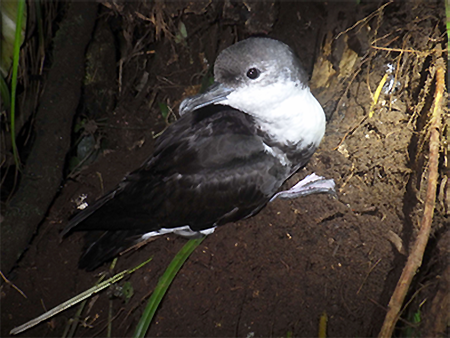Home > Research > Research Results > Research Results 2018 > A subspecies of Audubon's Shearwater in the Ogasawara Islands found to be a cryptic species based on DNA analysis
Update:April 4, 2018
Main content starts here.
A subspecies of Audubon's Shearwater in the Ogasawara Islands found to be a cryptic species based on DNA analysis
| Article title |
Phylogenetic position of endangered Puffinus lherminieri bannermani |
|---|---|
| Author (affiliation) |
Kazuto Kawakami (a), Masaki Eda (b) , Hiroe Izumi (b) , Kazuo Horikoshi (c) , Hajime Suzuki (c) (a) Department of Wildlife Biology, FFPRI, Tsukuba, Ibaraki, Japan. |
| Publication Journal |
Ornithological Science 17(1):11-18. 2018, DOI: 10.2326/osj.17.11( External link ) |
| Content introduction |
Puffinus lherminieri bannermani is a small black-and-white shearwater (Figure 1), which is endemic to the Ogasawara Islands, Japan. This seabird was discovered as a new species in 1915, and was called Bannerman’s Shearwater (P. bannermani). However, the classification of this seabird has changed repeatedly since then. Over a period of time, the species has been classified as a subspecies of widely distributed seabirds such as Little Shearwater (P. assimilis) and Tropical Shearwater (P. bailloni) due to similarity in their appearances. More recently, in the checklist of Japanese birds, it was treated as a subspecies of Audubon’s Shearwater P. lherminieri, which is also found in the Atlantic and Indian Oceans, and the nomenclature “Bannerman’s Shearwater” was rejected. However, there was a lack of scientific evidence for this change, and the phylogenetic relationship of this seabird with other seabirds was shrouded in mystery. This Ogasawara group of the shearwater was reported to breed on Kitaiwoto Island before World War II, but no colonies were found after the war. In 2007, there were finally confirmatory sightings of its colonies in the forests of Minamiiwoto and Higashijima, two small uninhabited islands. However, this shearwater is highly vulnerable to rat predation and deterioration of nesting environments by alien scrub Leucaena leucocephala, and the seabirds are now classified as endangered by Japan’s Ministry of the Environment. A DNA analysis of this seabird was conducted by the Forestry and Forest Products Research Institute in collaboration with Hokkaido University and the non-profit Institute of Boninology. Results from the DNA analysis of this seabird group residing in Ogasawara were compared with those of the shearwater species found in various parts of the world. The results indicated that this seabird group residing in Ogasawara has a completely different phylogenetic lineage compared with birds such as P. assimilis and P. lherminieri and appears to be a group of unique seabird species (Figure 2). The Ogasawara population should be split from the Audubon’s Shearwater, and the monotypic Bannerman’s Shearwater is recommended to be restored to a distinct species. This is comparable with the discovery of a novel species; the revelation of a hidden endemic species at the Ogasawara World Natural Heritage site should greatly increase the acknowledged environmental value of the area. Much remains unknown about the ecology and distribution of this seabird; thus, there is a need to conduct further research with the goal of conservation in mind.
Glossary 1) Puffinus lherminieri bannermani of the Ogasawara Islands. 2) Higashijima Island
Figure 1. Puffinus lherminieri bannermani of the Ogasawara Islands.
|
Copyright © Forest Research and Management Organization. All rights reserved.


